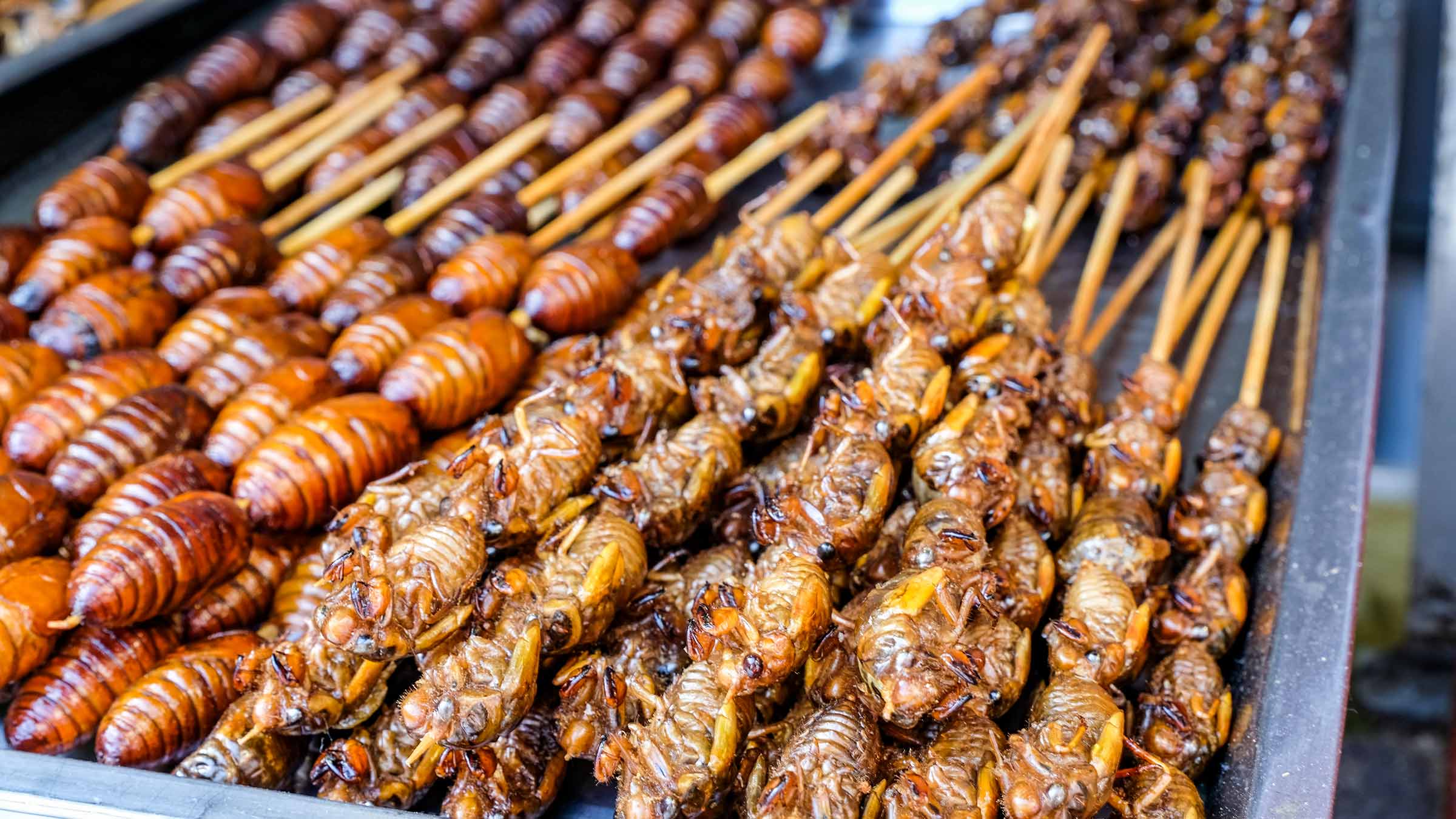
Looking for something unusual to wow — or gross out — family and friends at your next backyard barbecue? How about cooking up some earthy, crunchy cicadas?
When broods of cicadas emerge from on their 17-year cycles, it can be a unique opportunity to try an unusual, low-fat protein source.
Why would anyone want to eat cicadas?
Some things crossed my mind when I started writing this:
- “Wow, this is a great chance to eat something really exotic.”
- “What the heck am I thinking?”
Narrowing of the mind, widening of the waist. I consider cicadas an occasional gifts from the food gods, along with morels, asparagus and ramps.
As a kid growing up in a small town in Pennsylvania, I remember the sounds of the “locusts,” as we called them, as we were riding our bikes, building forts in the woods or hanging out at the swimming hole. It was the sound of summer.
We’d take the empty cicada shells and scare my friend’s younger sister by putting them in her hair, or just showing her one in our hand. She’d run away screaming. (I still feel kind of bad about that.)
My first experience with eating what I’ll call my “gateway bug” was a gift of spicy crickets from a couple of our chefs at the Ohio State Wexner Medical Center. I thought they were great, but I had to add them to some salty snack mix. As I grew used to the flavor and idea of eating bugs, I soon was able to proudly pop a handful of crickets into my mouth for a quick protein-packed snack.
Cicadas and many other insects such as ants, crickets and grasshoppers are great sources of protein, hugely abundant and earth friendly. Insects have been delicacies for many cultures for thousands of years. Even today, some people enjoy the guilty pleasure of chocolate-dipped bugs, eating them just like chocolate-covered pretzels.
How to catch cicadas for cooking
Your best bet is to find a wooded area away from older homes to lessen the chances for potential lead absorption from chipped paint. Steer clear of well-manicured yards due to the potential for lawn chemicals and other contaminants the cicadas may have absorbed.
Cicadas are at their most tender just out of the shell. The tough exoskeleton is not very tasty. Watch them climb up a tree and begin to molt from their outer shell. When they’re out of their shell, gently grab the soft bodies, blanch them in boiling water for one minute, then put them into a zip-lock bag and place them in the freezer before preparing them to cook.
If you fancy soft shell crabs, which are Atlantic Blue crabs that have just molted their old shell, then you may enjoy a cicada stir fry. Cicadas are related to shrimp, crayfish, lobsters, and other arthropods, so if you’ve ever eaten those, you’re just one step away from trying cicadas.
What do cicadas taste like?
I’m tempted to say they taste just like chicken, but they do have a nutty flavor and a nice crunch when sautéed in olive oil with a few seasonings tossed in for good measure. Old Bay seasoning is always a winner. However, I’m not so sure you can eat them without accompaniments. Go ahead and sauté them for a minute or two and top a nice dish of leafy greens with some crispy cicadas.
But please don’t use ranch dressing. After all, they’ve been waiting 17 years for this big dance, and you shouldn’t humiliate them one last time. A bit of extra virgin olive oil, some fresh lemon juice and a few cracks of black pepper will do just fine.
Are there really cookbooks devoted to cicadas recipes?
Believe it or not, yes. Cooking with Cicadas by R. Scott Frothingham includes gourmet recipes and explains how to prepare cicadas for snacks, meals and desserts. This cookbook features a variety of recipes from Italian and Moroccan to Asian and Mexican with enticing names including Cicada Frittata, Pasta a la Cicada, Cicada Curry, Cicada Tacos, Cicada Pad Thai and Caramel Cicada Crunch.
University of Maryland graduate school student Jenna Jadin published Cicada-Licious: Cooking and Enjoying Periodical Cicadas in 2004. Her book starts with a disclaimer to first consult with your doctor before eating cicadas, particularly for potential allergic reactions to substances within the cicadas.
People in many countries today consume cicadas, from Thailand to Mexico to northern African regions. Bug love has even made it to the great American pastime: a fresh cup of cooked insects is now available for $4 at a Major League Baseball concession stand. According to ESPN, the Seattle Mariners are selling toasted gluten-free grasshoppers tossed in chili-lime salt.
My suggestion for those first-timer cicada connoisseurs is to go slowly, have a friend nearby for support, spice ‘em up and enjoy. Otherwise, you’ll have to wait 17 more years before you can try eating something this exotic again.
Recipe for Cicada Stir-Fry (Courtesy of Cicada-Licious: Cooking and Enjoying Periodical Cicadas)
Ingredients:
- 1 onion, minced
- 2 tablespoons fresh coriander (cilantro), chopped
- 1 tablespoon fresh ginger, minced
- 3/4 cup sliced carrots
- 3/4 cup chopped cauliflower and/or broccoli
- 1 can water chestnuts
- 3/4 cup bean sprouts
- 3/4 cup snow peas
- 40 blanched newly hatched (teneral) cicadas
Directions:
- Capture cicadas at night as they emerge from the ground.
- Blanche for 1 minute in boiling water. They can now be stored in freezer or used immediately in recipes.
- In a wok or other suitable pan, heat a couple tablespoons of vegetable oil. Add ingredients in the order listed above when those in the most recent addition are partially cooked.
- Serve over whole-grain rice and add soy sauce to taste
Yield: 4 main course servings

Healthy eating is within your reach!
Make an appointment with our dietitians or nutritionists.
Schedule an appointment



